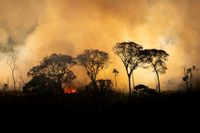A study by the Socio-Environmental Institute (ISA), released on Wednesday, April 2, 2025, reveals that indigenous territories in the Caatinga, Atlantic Forest, Pampa, and Pantanal biomes have a 31.5 percent higher level of environmental preservation compared to surrounding areas. This significant finding underscores the critical role indigenous lands play in safeguarding Brazil's diverse ecosystems.
The research analyzed 223 territories, which have collectively lost an average of 36.5 percent of their original vegetation, irrespective of their stage of demarcation. This analysis focused on the devastation in these biomes during the first decade of the 2000s, highlighting alarming trends in environmental degradation.
Among the biomes, the Pampa stands out with the highest proportion of deforested area, having lost 62.5 percent of its original vegetation. In the Atlantic Forest, a staggering more than 90 percent of deforestation had already occurred by the year 2000 in many of these regions. The ISA report indicates that delays in the demarcation of indigenous territories are contributing factors to this environmental degradation.
According to ISA, "Only effective indigenous ownership can ensure the socio-environmental integrity of indigenous territories. Demarcation, protection, and territorial management policies must be integrated, considering social, cultural, and environmental aspects." This statement emphasizes the importance of recognizing indigenous rights and the need for protective measures to sustain these vital ecosystems.
Furthermore, the report highlights that demarcation not only prevents further destruction but also fosters vegetation regeneration. The ISA's findings suggest that effective management strategies employed by indigenous communities are crucial for maintaining ecological balance.
In a related concern, Brazil is grappling with a severe forest fire crisis, which escalated dramatically in 2024. A commentary by Robert Muggah and Ilona Szabo from the Igarapé Institute examined the alarming statistics, noting that Brazil registered 237,000 fires last year, devastating over 30.8 million hectares of vegetation—an area comparable to the size of Italy. This represented a staggering 79 percent increase in burned areas compared to 2023.
The Amazon rainforest was the hardest hit, accounting for 58 percent of the total burned area. The Brazilian government responded to the escalating crisis by declaring a nationwide environmental emergency, particularly in anticipation of the 2025 fire season.
In early 2025, the Supreme Court mandated that the federal government and all Amazon and Pantanal states develop emergency fire management plans to combat this growing threat. The consequences of these fires extend beyond immediate environmental destruction, with severe health impacts linked to prolonged exposure to wildfire smoke, including respiratory illnesses and cardiovascular diseases.
As the fires rage on, they disrupt agricultural production, supply chains, and tourism, leading to billions in economic losses annually. Muggah emphasizes that the underlying drivers of these fires are primarily human-made, stemming from deforestation, land grabbing, and agricultural practices that often involve the deliberate use of fire.
Illegal logging and mining further exacerbate the problem, as fires are frequently set to obscure deforestation or create access routes for unauthorized extraction. Climate change and extreme weather conditions have intensified, making rainforests drier and more susceptible to fires than ever before.
Brazilian authorities have implemented various measures to mitigate the spread of forest fires, albeit with mixed results. For instance, the government has reinforced zero deforestation policies through initiatives such as supporting firefighters and financing firefighting equipment via the Amazon Fund and Operation “Guardiões do Bioma,” which focus on combating illegal deforestation and environmental crimes.
Moreover, states like Pará have introduced tax benefits for landowners who preserve forest cover, aiming to discourage slash-and-burn agriculture. Another promising initiative announced by the Ministry of Environment is the establishment of governance offices in 70 Amazon municipalities, aimed at curbing deforestation and forest fires. These offices are expected to provide vehicles, boats, drones, and training to support fire prevention and reduction efforts.
Brazil is also investing heavily in new technologies to prevent and manage fires. The Prevfogo Program, managed by the Brazilian Institute of Environment and Renewable Natural Resources (IBAMA), integrates satellite monitoring and technological advancements to enhance fire management strategies.
Addressing Brazil’s monumental forest fire crisis requires a multifaceted approach. While technology plays a crucial role, enhanced communication, outreach, and a deeper understanding of the political economy of wildfires are equally essential. Governments need timely and specific insights into the determinants of forest fires to develop effective strategies.
In the long run, nature-based solutions, particularly land restoration and conservation projects that consider fire risks, are critical for fostering resilient forest protection. Innovative financing from public, private, and philanthropic sectors is vital to scale up these measures. Tools such as green bonds, climate funds, and performance-based incentives can mobilize resources for fire prevention and forest restoration efforts.
Given the transboundary nature of forest fires, regional cooperation is also crucial. The impacts of fires in neighboring countries, such as Bolivia, have significant repercussions for Brazil’s Pantanal. As the threat of forest fires continues to grow, Brazil and its partners must adopt a comprehensive strategy rather than piecemeal approaches.
This necessitates a combination of smart public policy, sustained monitoring and enforcement, economic incentives, technological innovation, and the involvement of traditional and local communities. Powerful multi-stakeholder coalitions can also inspire action, as seen in initiatives like the Wildfire Resilience Initiative and the Fire Grand Challenge, which focus on enhancing resilience against wildfires.
The challenges facing the Amazon and other biomes are enormous, but so are the opportunities to transform the landscape of forest management in Brazil.





